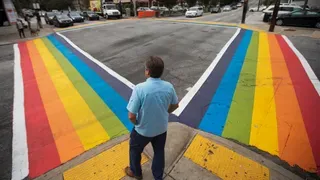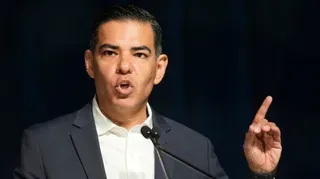November 28, 2013
The Tough Road for LGBT Asylum Seekers (Part 1)
Kevin Langson READ TIME: 6 MIN.
Editor's note: This is the first in a two part series that explores the trials and tribulations LGBT asylum seekers experience.
A well-known trope in the narrative of the American LGBT experience is the great escape: The sexual or gender misfit leaving Middle America to take refuge in New York or San Francisco or some other large city that is more embracing of diversity. It's a pragmatic survival tactic -- a form of migration shot through with excitement for freedom and social opportunities.
As Neil Grungras, founder and executive director of Organization for Refuge, Asylum, and Migration (ORAM) points out, LGBT men and women who seek asylum in Western countries are driven by the same desire. The trajectories are essentially the same, though most sexual misfit migrants in this country don't make that connection. Although a small town in North Carolina can be extremely anti-gay, it doesn't quite compare to the life-risking plight of a gay man from Central America who navigates treacherous borders and faces detention in Texas. That experience also doesn't compare to a transgender Iranian who escapes to Turkey only to be restricted to a deeply religious town in Eastern Turkey where he/she must hide at home while hoping against odds for resettlement in North America or Europe.
In the U.S., we experience flashes of international consciousness: Currently, news outlets are buzzing about such topics as Russia's highly controversial laws that threaten the safety of innumerable LGBT individuals and the evangelical takeover of Uganda. But what of the Russians, Ugandans, and countless others who never make the news, who are risking everything to make it to safe shores?
At the same time mainstream American LGBT organizations are fighting for marriage equality and non-discrimination in the workplace (worthy causes), groups like ORAM in San Francisco and Heartland Alliance (through its government-funded Rainbow Welcome Initiative) in Chicago are working to make the U.S. a viable home for men and women who have been beaten, raped, and incarcerated for their sexual orientation.
The story of LGBT asylum is replete with both tragedies and victories, which is reflected in the particular mix of optimism and grievance evinced by insiders while discussing the matter.
International Programs Associate at Heartland Alliance, Daniel Weyl, tells EDGE about the progress that has been made in training refugee service agencies to be sensitive to the needs of LGBT claimants. This is echoed by Grungras. He also discusses persisting shortcomings, like government agencies that still lack sensitivity, abysmal long waiting periods for refugees seeking resettlement, lack of community support for asylum seekers (who, unlike refugees, lack access to any government-supported programs) and violence.
These asylum seekers are often fleeing violence in their homelands, then are subjected to further violence in U.S. detention centers, where applicants sometimes spend grueling waits, which generally range from eight days to nine months, for those deportation orders. Weyl, Grungras and others explain the distinction between the hardships of LGBT asylum seekers and that of their heterosexual counterparts is the lack of family and community support.
JD Newsom at Refugee Services of Texas told of his frustrated efforts to accompany an Iranian transgender woman to an event sponsored by a LGBT organization in Dallas. He wanted to help her make social contacts, but she was too afraid to be public about who she was or to confront the LGBT subculture.
Eventually she did integrate, making friends and attaining employment; but it was a process she had to do at her own pace, shaking off deep-rooted trauma.
Grungras laments well under 500 of the 700,000 refugees that the U.S. receives a year are LGBTQ, but he is explicit in praising the professionals who are trying to resettle refugees in the U.S., such as the adjudicators who approve many more cases than certain EU countries. He describes them as overwhelmed but well-intentioned, saying that there are "a million competing interests... The thing is we always end up waiting at the end of the line."
More contentious is his assertion that agencies need to put LGBT cases at the front of the queue, which isn't the contradiction it might initially seem to some.
"If you know someone's going to become homeless, put their file first so their wait for legal representation is shorter," Grungras told EDGE. It's a matter of determining who is the most vulnerable, and that is generally those with no family or community support.
Until an European Union Court ruling on Nov. 7, EU countries were allowed to reject asylum claims based on "discretion," meaning that individuals could simply return to their countries of origin and conceal their sexuality in order to be secure, something never required of religious or political asylum seekers, as Grungras points out.
In the U.S. this was never official policy; still, there is a "culture of disbelief," as Grungas puts it. The burden is on claimants to prove that they are LGBT and that their lives are at risk. Cases are not allowed a "presumption of credibility," hence the reality that most applicants are turned away.
Gathering evidence is often difficult not only because their identities are kept secret in their home countries, but also because one does not normally think to gather photographs or revealing correspondence with same-sex lovers.
Additionally, the U.S. is the only country to require that individuals file for asylum within a year of their arrival. The Real ID Act's restriction proves to be a formidable obstacle for some, as it takes time for individuals to feel comfortable being open about their sexuality and to gather the necessary evidence.
"In the U.S., the issue is not the legal system; it is access," Grungras said. Otherwise, unlike Europe, whose proximity to North Africa and the Middle East means that it gets an influx of applicants, it is a difficult journey to the U.S. without sponsorship. This statement, however, also resonates with the fact that despite all the positive things that are happening in this country, it is incredibly arduous for newly arrived LGBT's, particularly asylum seekers.
When asked how they manage to make it in U.S. cities that are liberal and ethnically diverse, but outrageously expensive, Grungras says that many become homeless. The question is how to bolster grassroots networks and allocate government resources so that those whose life is endangered are not left in the cold.
"The community has to care... It's got to take the place of the family," Grungras said. When welcoming individuals who have suffered from trauma, there must be a personal touch. Pumping government money into service programs is needed, but not enough. An integral part of this is encouraging LGBT centers and organizations to accommodate these new members of the community.





